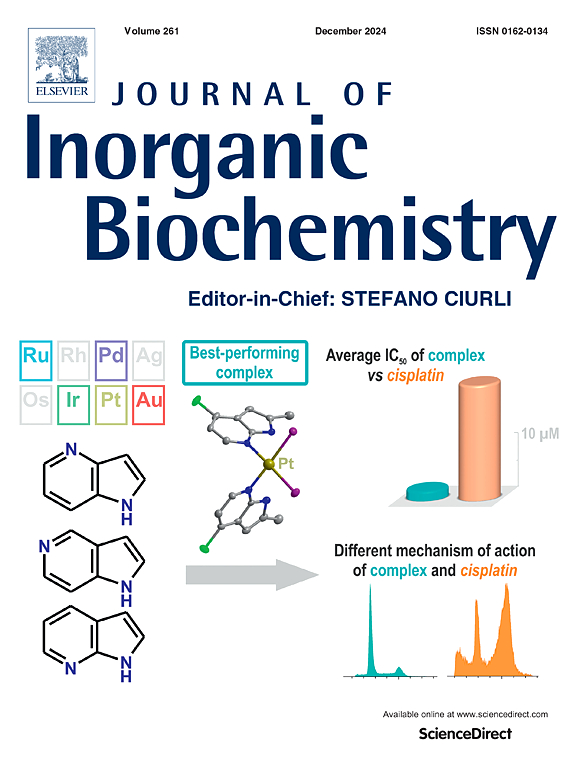氨基甲酸卟啉衍生物和Cu(II)金属卟啉作为g -四联体结合剂:合成、单晶表征、结合能力和抗肿瘤潜力。
IF 3.2
2区 化学
Q2 BIOCHEMISTRY & MOLECULAR BIOLOGY
引用次数: 0
摘要
具有g -四重体结构的端粒是公认的抗肿瘤靶点。发现卟啉的芳面与Gq结构可形成π-π相互作用,金属离子与卟啉配位可使其芳面增加。因此,本文设计并合成了两个氨基卟啉衍生物(1和2)和一个Cu(II)金属卟啉(1-Cu)。获得了1和1- cu的单晶,并在分子水平上分析了与结合相互作用相关的特性。通过进一步的Hirshfeld表面、分子静电势和前沿分子轨道分析,揭示了卟啉环、苯甲酸酯侧链和配位铜离子可能与Gq结构形成协同结合力。随后,用紫外可见光谱、荧光光谱、圆二色光谱和PCR-stop法检测其结合能力和结合模式。结果表明,三种化合物与Gq的选择性结合常数均为3.19 × 107,高于与双链DNA的选择性结合常数。进一步的分子对接和分子动力学模拟支持了末端叠加和凹槽结合的协同模式。最后,通过细胞毒性、细胞染色、细胞凋亡和细胞迁移实验来评价其抗肿瘤潜能。结果表明,与阳性对照药相比,1和1- cu对肿瘤细胞的IC50值显著降低,对肿瘤细胞的细胞毒性远高于对正常细胞的细胞毒性。因此,这项工作为设计针对Gq端粒的新型药物提供了重要的信息。本文章由计算机程序翻译,如有差异,请以英文原文为准。

An insight into porphyrin carbamate derivatives and a Cu(II) metalloporphyrin as G-quadruplex binder: Synthesis, single crystal characterization, binding ability and anti-tumor potential
Telomere with a G-quadruplex (Gq) structure is a recognized anti-tumor target. It was found that the aromatic plane of porphyrin may form π-π interactions with the Gq structure and the coordination of metal ions to porphyrin may increase its aromatic plane. Therefore, in this work, two porphyrin carbamate derivatives (1 and 2) and a Cu(II) metalloporphyrin (1-Cu) were designed and synthesized. The single crystals of 1 and 1-Cu were obtained and characteristics related to the binding interactions were analyzed at molecular level. With further Hirshfeld surface, molecular electrostatic potential, and frontier molecular orbital analyses, it was revealed that porphyrin ring, phenyl carbamate side chain and the coordinated copper ion may form synergistic binding forces with the Gq structure. Subsequently, binding ability and binding mode were tested with UV–Vis, fluorescence, and circular dichroism spectroscopies and PCR-stop method. Result showed that all three compounds selectively bound to Gq with the highest binding constant of 3.19 × 107, which was an order of magnitude higher than those to the duplex DNA. Further molecular docking and molecular dynamics simulations supported the synergistic end stacking and groove binding modes. At last, anti-tumor potentials were evaluated with cytotoxicity, cell staining, cell apoptosis, and cell migration assays. Results showed that compared with the positive control drug, the IC50 values of 1 and 1-Cu to the tumor cells were significantly lower, and their cytotoxicities to tumor cells were much higher than those to normal cells. Therefore, this work provided important information for designing novel drugs targeting Gq telomere.
求助全文
通过发布文献求助,成功后即可免费获取论文全文。
去求助
来源期刊

Journal of Inorganic Biochemistry
生物-生化与分子生物学
CiteScore
7.00
自引率
10.30%
发文量
336
审稿时长
41 days
期刊介绍:
The Journal of Inorganic Biochemistry is an established international forum for research in all aspects of Biological Inorganic Chemistry. Original papers of a high scientific level are published in the form of Articles (full length papers), Short Communications, Focused Reviews and Bioinorganic Methods. Topics include: the chemistry, structure and function of metalloenzymes; the interaction of inorganic ions and molecules with proteins and nucleic acids; the synthesis and properties of coordination complexes of biological interest including both structural and functional model systems; the function of metal- containing systems in the regulation of gene expression; the role of metals in medicine; the application of spectroscopic methods to determine the structure of metallobiomolecules; the preparation and characterization of metal-based biomaterials; and related systems. The emphasis of the Journal is on the structure and mechanism of action of metallobiomolecules.
 求助内容:
求助内容: 应助结果提醒方式:
应助结果提醒方式:


